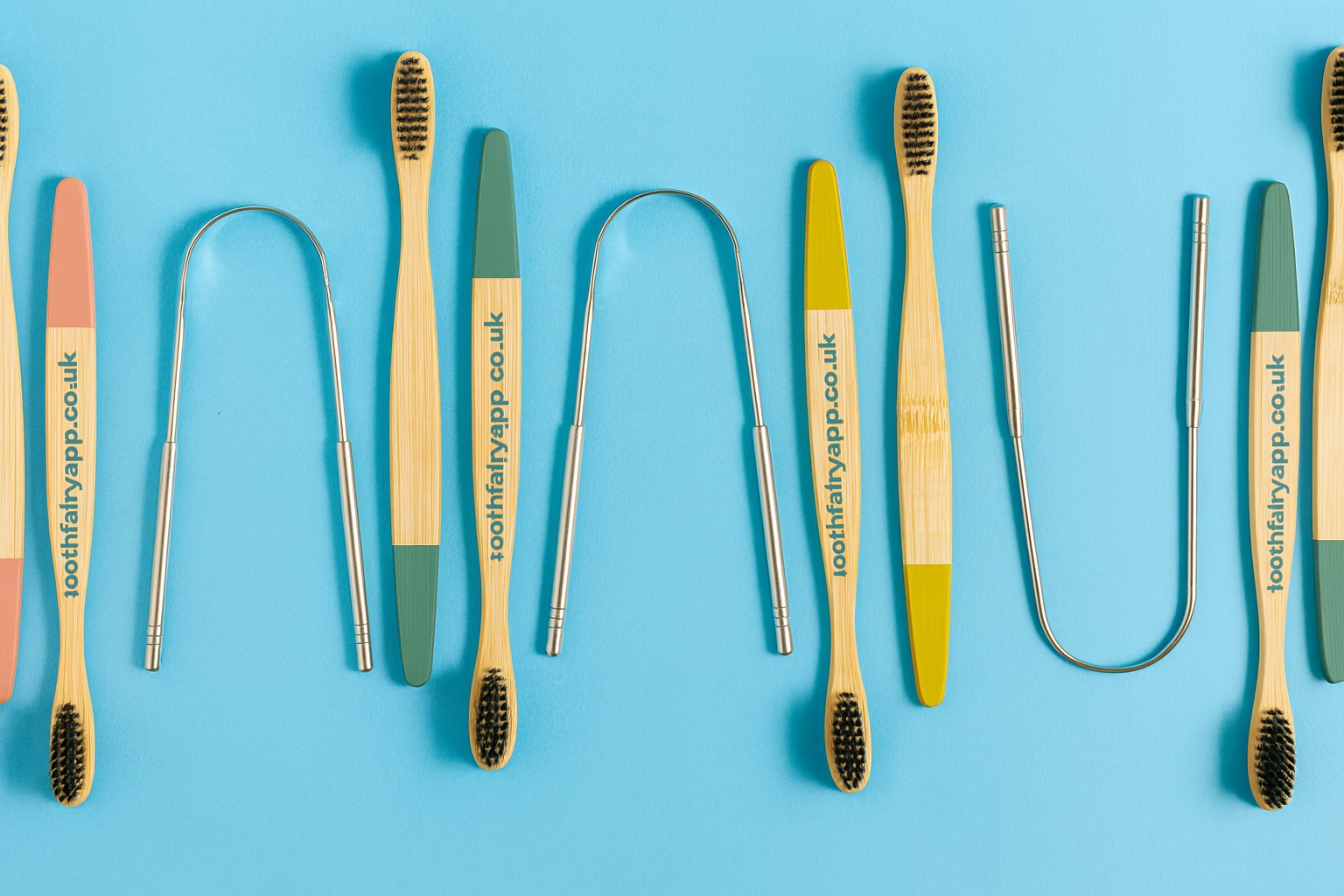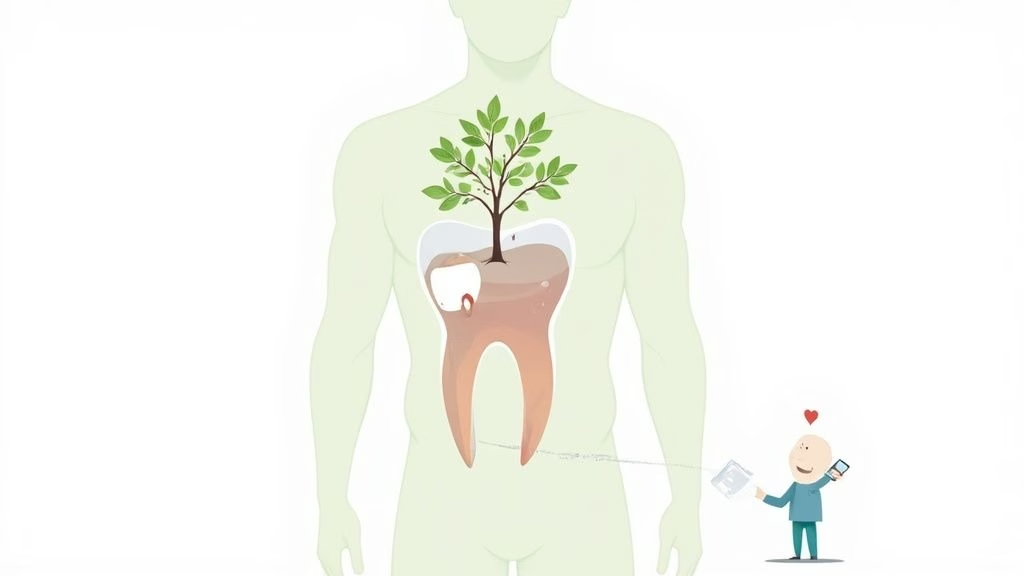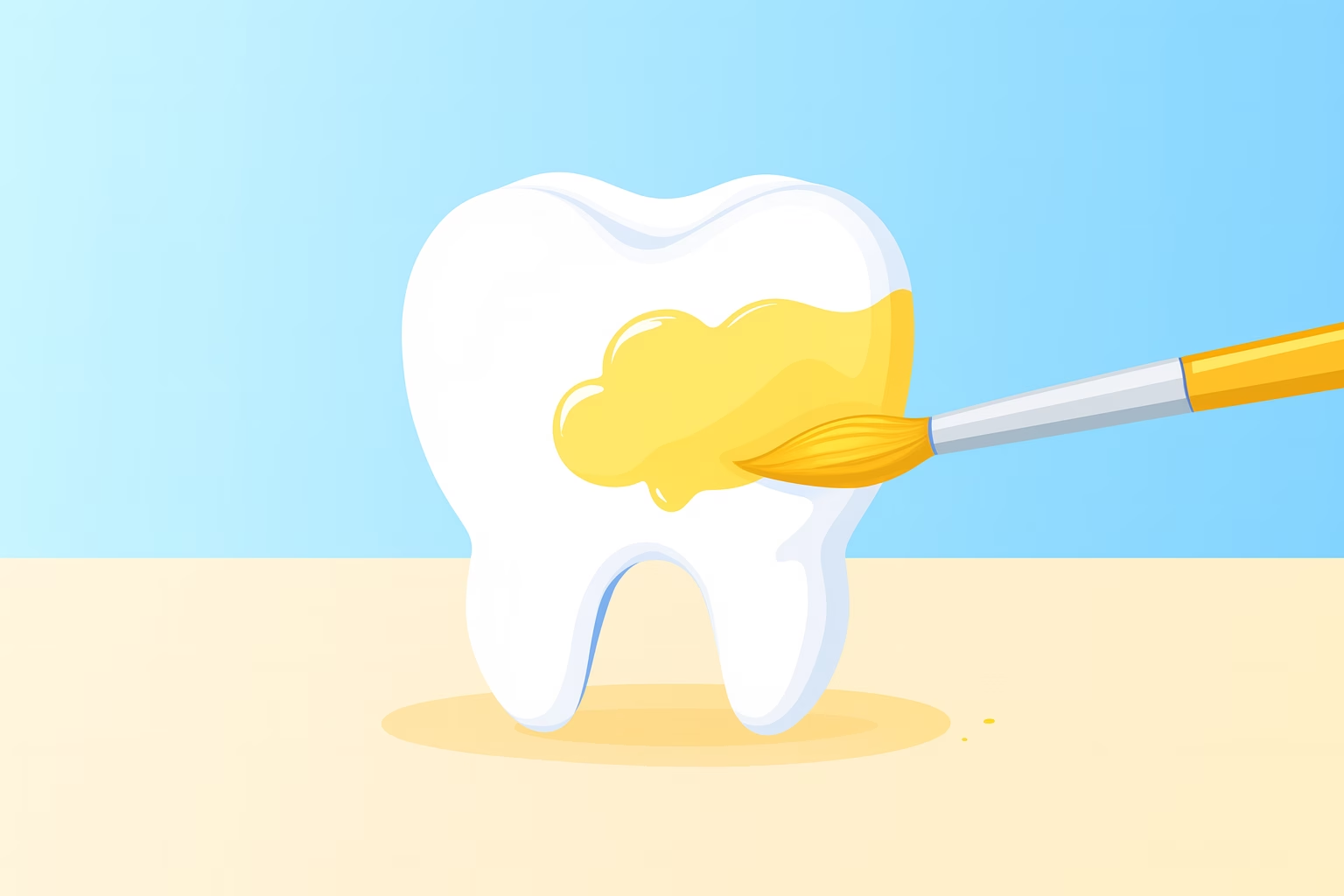How to Choose an Electric Toothbrush: A UK Guide
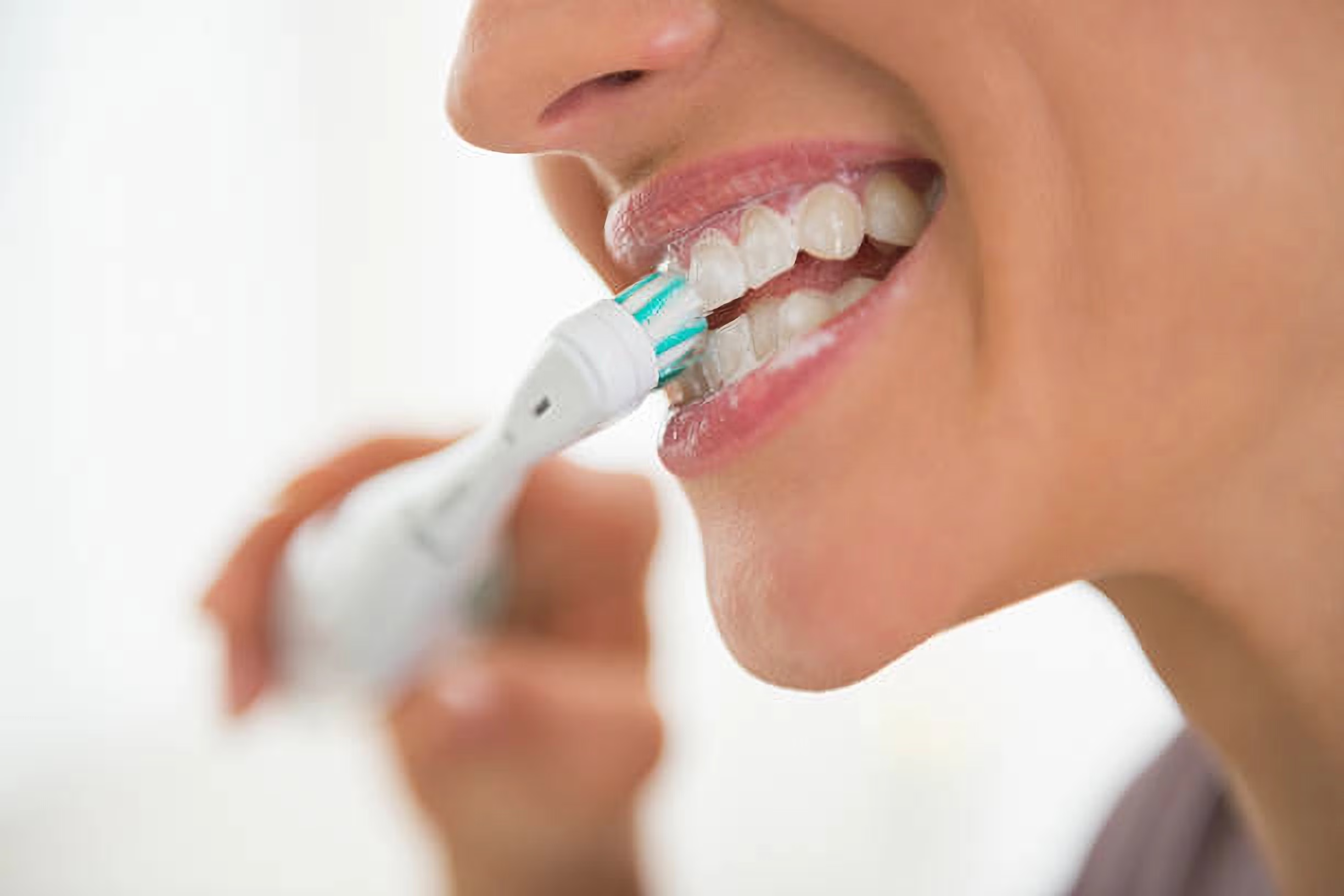
Picking the right electric toothbrush really boils down to three things: your own dental needs, the type of cleaning action you prefer (oscillating vs. sonic), and a few must-have features like a two-minute timer and a pressure sensor. When you line these up with what you want to achieve—whether that’s healthier gums or a whiter smile—you’ll find the perfect brush for the job.
Your Quick Guide to Choosing an Electric Toothbrush
Let’s be honest, staring at a wall of electric toothbrushes can feel a bit much. There are so many models, features, and price points. The secret is to ignore the noise and focus on what actually matters for your mouth.
A good toothbrush isn’t just a gadget; it’s a crucial tool in your oral health toolkit. It works alongside other treatments, like clear aligners, to keep your teeth and gums in top shape. That’s why getting this choice right is such a big first step towards a healthier smile.
Think of it like a decision tree: first, figure out your specific needs, then choose the tech that suits you, and finally, pinpoint the features you can’t live without.
As you can see, the journey always starts with you, not with a brand name. A methodical approach always pays off. It’s a bit like following an electric scooter buying guide—you break down the features to find the perfect match for your lifestyle.
At Toothfairy, we’re all about smart, accessible dental care, whether it’s cosmetic work or our affordable teeth straightening options that offer a more convenient alternative to other aligner brands. And it all starts with the basics, like finding the right toothbrush.
Electric Toothbrush Features at a Glance
To simplify things even further, here’s a quick rundown of the key features to consider. Use this table to zero in on what’s most important for your dental goals.
| Feature | What to Look For | Why It Matters for Your Smile |
| Cleaning Technology | Oscillating-Rotating (small, round heads) or Sonic (vibrating, traditional-shaped heads). | Oscillating heads are great for polishing and removing plaque, while sonic tech can be gentler and better at reaching between teeth. |
| Brushing Modes | Look for modes like ‘Sensitive’, ‘Whitening’, ‘Gum Care’, or ‘Deep Clean’. | Different modes let you customise your clean. If you have sensitive gums, a dedicated mode is a game-changer. |
| Two-Minute Timer | A built-in timer that pulses or stops every 30 seconds. | Dentists recommend brushing for two minutes. The timer ensures you hit that target and clean each part of your mouth evenly. |
| Pressure Sensor | A light or vibration that warns you when you’re pressing too hard. | This is essential for protecting your enamel and gums from damage caused by aggressive brushing. |
| Battery Life | Check for two weeks or more on a single charge. Consider USB charging for travel. | A long battery life means less hassle, especially if you’re often on the go. |
| Brush Head Cost | Research the price of replacement heads before you buy the handle. | The ongoing cost of replacement heads can add up, so factor this into your budget from the start. |
Taking a moment to think through these features will ensure you invest in a toothbrush that not only feels great to use but also delivers the results your smile deserves.
Finding the Right Brush Head and Bristles
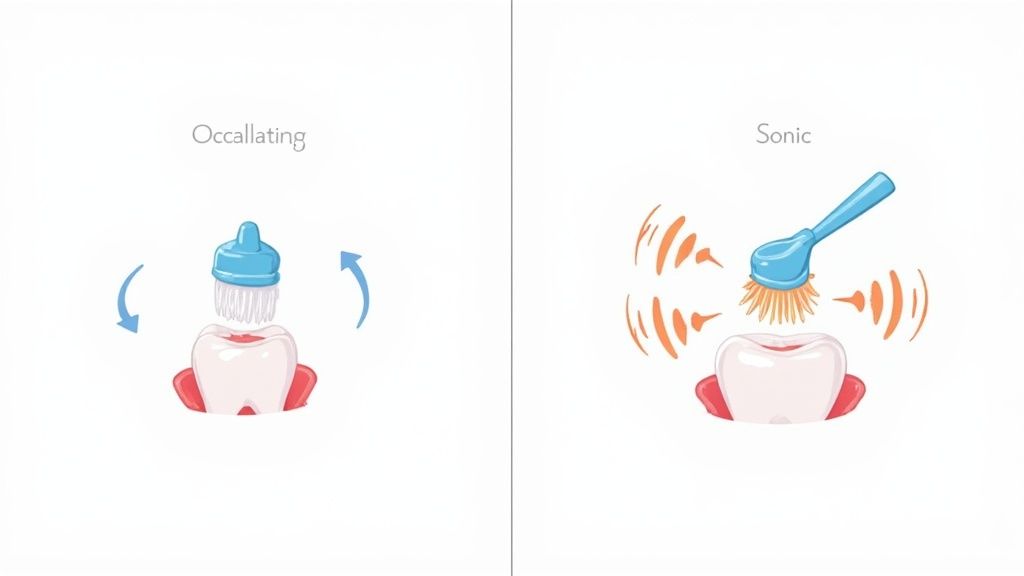
We often focus on the fancy handle of an electric toothbrush, but the real workhorse is the brush head. Getting this part right—from the bristles to the shape—is what makes all the difference in your daily clean.
The first thing to look at is bristle softness. You might see ‘medium’ or even ‘hard’ bristles on shop shelves, but take it from the experts: UK dentists almost always recommend soft bristles. They have just the right amount of flex to sweep away plaque without being abrasive on your tooth enamel and gums.
This is non-negotiable if you have sensitive teeth or are going through any kind of dental work. Think about someone using clear aligners to straighten their teeth; healthy gums are essential. Harsh bristles can easily lead to irritation or recession, which is the last thing you want to deal with.
“Choosing soft bristles is a must for long-term oral health. So many preventable issues, like enamel wear and gum recession, come from simply brushing too aggressively with bristles that are too hard.”
Matching Head Shape to Your Mouth
Once you’ve settled on soft bristles, consider the shape and size of the brush head itself. This really comes down to what works best for your mouth’s unique geography. The two main shapes you’ll come across are round and elongated (which looks more like a traditional manual brush).
- Round Heads: These are fantastic for a tooth-by-tooth clean. Because they’re smaller, they can get into all the nooks and crannies, especially around those tricky back molars that often get neglected.
- Elongated Heads: These cover more surface area at once, a bit like a manual brush, which some people find more familiar. They can be very effective, but might struggle to clean crowded or crooked teeth with the same precision as a round head.
On top of that, many brands now offer speciality heads for different goals. You’ll find options designed for whitening, for an extra-deep clean, or for ultra-sensitive gums.
A final, practical point: brush heads are a recurring cost. Before you invest in a toothbrush, have a quick look at the price of its replacement heads. A cheap handle isn’t much of a bargain if the refills break the bank every few months. This is exactly the kind of smart, forward-thinking approach we champion at Toothfairy—making sure your dental care is both effective and affordable for the long haul.
Oscillating vs Sonic Cleaning Technology
When you start digging into how to choose an electric toothbrush, you’ll quickly hit the biggest fork in the road: oscillating or sonic? Both technologies are brilliant at blasting away plaque, but they get the job done in very different ways. The one you pick really defines what it feels like to brush your teeth every day.
Think of an oscillating-rotating brush as a precision tool. Its small, round head spins and pulses, scrubbing each tooth individually. Many people love this because it delivers a powerful, deep-clean feeling, almost like a professional polish.
Then you have sonic technology. These brushes look more like a manual toothbrush and work by vibrating at incredibly high speeds. This side-to-side motion whips up your toothpaste and saliva into a flurry of micro-bubbles, cleaning plaque even from areas the bristles don’t physically touch. The sensation is often described as gentler and less aggressive.
This decision is more relevant than ever here in the UK. With the European electric toothbrush market valued at roughly $1.24 billion in 2024, there’s a huge variety to choose from. While oscillating brushes have traditionally dominated, sonic models are gaining a lot of ground, especially for those who want a gentler clean. If you’re curious about the market dynamics, Grand View Research offers some detailed insights into these trends.
Which Brushing Action Is Right For You?
So, which one should you choose? Honestly, there’s no single “best” option. It all comes down to your teeth, your gums, and what feels right in your mouth.
If you have sensitive gums, for example, or you’re straightening your teeth with aligners from a provider like Toothfairy, the gentle sweeping of a sonic brush is probably a better fit. But if you’re after that powerful, fresh-from-the-hygienist feeling and don’t have sensitivity issues, an oscillating brush will likely give you the satisfying clean you’re looking for.
My best advice? Think about your number one priority. Is it maximum plaque obliteration, or is it protecting sensitive gums and dental work? Your answer will almost always point you to the right technology.
To make things a bit clearer, let’s break down the key differences between the two.
Oscillating vs Sonic Technology Compared
Here’s a direct comparison of the two main electric toothbrush technologies to help you decide which is better for your oral health needs.
| Feature | Oscillating-Rotating | Sonic Vibration |
| Cleaning Action | A small, round head that spins and pulses. | A brush head that vibrates at very high speeds. |
| Best For | Intense, tooth-by-tooth cleaning and stain removal. | People with sensitive gums or complex dental work. |
| Feel | A powerful, almost polishing sensation. | A gentler, sweeping, and vibrating feel. |
| Brush Head | Usually small and round for precision. | Typically elongated, similar to a manual brush. |
Ultimately, whether you choose the focused power of an oscillating brush or the dynamic, gentle clean of a sonic one, you’re already taking a huge step up from a manual brush. Both are proven to significantly improve your oral hygiene.
Essential Features vs. Unnecessary Gadgets
It’s easy to get dazzled by the technology packed into modern electric toothbrushes. But let’s be honest, not every bell and whistle is going to give you a healthier smile. The real trick is learning to spot the genuinely useful features amongst the clever marketing. Your aim is to find a brush that delivers real value, aligning with the Toothfairy philosophy of smart, effective dental care—without paying a premium for gadgets you’ll never use.
There are a couple of features that I consider non-negotiable: the two-minute timer and the pressure sensor. The timer is your built-in coach, usually pulsing every 30 seconds, guiding you to brush for the dentist-recommended time and helping you clean each part of your mouth evenly.
The pressure sensor, however, might be the most important feature of all. It’s your safety net, alerting you when you’re pushing too hard and helping you avoid irreversible damage to your gums and enamel.
“A pressure sensor isn’t a luxury; it’s a safeguard. So many people cause gum recession by unknowingly applying too much force. This one feature can save you from a lot of future dental problems.”
Deciphering The ‘Nice-to-Have’ Extras
Once you’ve ticked off the essentials, you’ll find a whole world of optional extras. For some people, these can be brilliant, but for others, they’re just clutter.
- Multiple Cleaning Modes: Options like ‘Whitening’, ‘Gum Care’, or ‘Sensitive’ can be genuinely helpful if you have a specific goal in mind. For example, if you’re using clear aligners for teeth straightening, a gentle ‘Gum Care’ mode is perfect for cleaning around sensitive spots without causing irritation.
- Bluetooth Connectivity and Apps: High-end brushes often sync with an app to track where you’ve brushed and highlight missed spots. This can be fantastic for someone who needs that extra push or is tracking their progress for an orthodontist. For most of us, though, it’s a novelty that wears off after the first week.
- AI Tracking: This takes app connectivity to the next level, using sensors to map your mouth in real-time. The technology is impressive, but you have to ask yourself: do you really need an AI coach to brush your teeth properly?
The UK electric toothbrush market is incredibly competitive. Brands are constantly pushing these advanced features to stand out, and it’s clear consumers are paying attention. This has created a moderately concentrated market where the big names fight for your business. This trend means it’s more important than ever for UK buyers to think carefully about which features will actually benefit them. If you’re interested in the data, you can explore detailed insights on UK consumer trends to see how these features are shaping what’s on offer.
At the end of the day, picking the right electric toothbrush is all about finding your perfect balance. Start with the non-negotiables—the timer and pressure sensor—and then take an honest look at whether the high-tech extras will genuinely improve your daily routine or just make it more complicated.
The True Cost of Your Toothbrush – It’s Not Just the Price Tag
When you’re weighing up your options, it’s easy to focus on the initial price. But an electric toothbrush is a bit like a car – the price you pay upfront is only part of the story. To really understand the investment you’re making in your oral health, you need to look at the total cost of ownership.
The price on the box can certainly swing wildly. You can find perfectly decent entry-level models for under £50, which will usually give you the essentials like a timer and pressure sensor. Step up to the mid-range, somewhere between £50 and £150, and you’ll start seeing more cleaning modes and better battery life. Go for a premium model over £200, and you’re in the realm of smart features, app connectivity, and AI coaching.
But here’s the thing many people forget: the ongoing cost is all in the replacement brush heads. These aren’t optional; they need swapping out every three months to stay effective. A cheap handle can feel like a great deal, but if its replacement heads are pricey, it’ll sting your wallet more over time.
Thinking About Long-Term Value
So, when you’re figuring out how to choose an electric toothbrush, try to look past the initial purchase. I’ve often seen patients find that a slightly more expensive brush with affordable, easy-to-find replacement heads works out to be a much better value over two or three years.
A quick tip: Calculate the total cost over two years to get a real comparison. Just use this simple formula: (Handle Price) + (8 x Replacement Head Price). This paints a much clearer picture of what you’re actually signing up for.
Here at Toothfairy, we believe that investing in the right preventative tools is the smartest way to manage your dental care. It’s an approach that saves you money on bigger, more complex treatments later on. Whether you’re considering affordable teeth straightening to rival a specific aligner brand or need urgent dental advice, looking after the fundamentals is the best strategy for your health and your bank balance. Your toothbrush is a huge part of that.
A Few Final Questions Answered
Even with all the features laid out, it’s natural to have a few last-minute questions before you commit. Picking the right brush is a big deal for your daily routine. Let’s clear up some of the most common queries I hear, so you can feel totally confident in your choice.
Are the Expensive Toothbrushes Really Worth It?
This is probably the number one question, and the honest-to-goodness answer is… it depends. When you see a toothbrush with a price tag north of £150, you’re usually paying for high-tech extras like app connectivity and AI tracking. These can be fantastic motivators for some, turning brushing into a bit of a game, but they don’t necessarily give you a dramatically better clean than a solid mid-range option.
What really matters are the fundamentals. As long as your brush has a dependable two-minute timer and, crucially, a pressure sensor, you’ve got the most important tools for protecting your oral health.
How Often Should I Be Changing the Brush Head?
Plan on swapping out your brush head every three months. A good way to remember is to change it with the seasons. If you notice the bristles are looking frayed or bent out of shape before then, it’s definitely time for a new one. Worn-out bristles just can’t clean properly and can become a breeding ground for germs.
Many modern brush heads have a clever built-in reminder system – you’ll see indicator bristles that fade from blue to white when it’s time for a change.
Here’s a pro tip: always pop on a fresh brush head after you’ve been ill with a cold or the flu. It’s a simple step to help you avoid getting sick again.
Can I Use an Electric Toothbrush with Braces or Clear Aligners?
Yes, you absolutely can – and in fact, I’d strongly recommend it. Keeping your teeth and gums in top shape is even more vital when you’re going through orthodontic work. An electric toothbrush is simply better at getting into all the nooks and crannies around brackets and wires than a manual brush ever could be.
If you’re using clear aligners from a provider like Toothfairy, an electric brush is your best friend for keeping gums healthy and inflammation-free. The key is to use a soft-bristled head and stick to a gentle cleaning mode. This prevents putting any extra force on your teeth or attachments, ensuring your treatment—which is often a smarter and more affordable path than some big-name brands—is a complete success.
Ready to match that brilliant new toothbrush with an equally smart approach to your smile? At Toothfairy, we provide everything from affordable, dentist-led clear aligner treatment to on-demand emergency dental care, right from our app. Find out more about a better way to manage your dental health at https://www.toothfairyapp.co.uk.
Last updated on October 27, 2025

Toothfairy Care Team
Toothfairy, is the world's smartest dental app, that connects patients to a dentist for a range of issues, from emergencies, cosmetics, prescriptions to virtual exams.
Toothfairy Care Team
Toothfairy, is the world's smartest dental app, that connects patients to a dentist for a range of issues, from emergencies, cosmetics, prescriptions to virtual exams.

